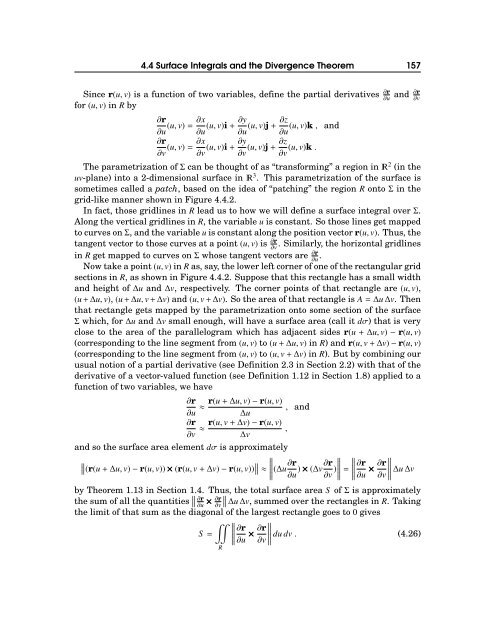Michael Corral: Vector Calculus
Michael Corral: Vector Calculus
Michael Corral: Vector Calculus
You also want an ePaper? Increase the reach of your titles
YUMPU automatically turns print PDFs into web optimized ePapers that Google loves.
4.4 Surface Integrals and the Divergence Theorem 157<br />
Since r(u,v) is a function of two variables, define the partial derivatives ∂r<br />
∂u<br />
for (u,v) in R by<br />
∂r<br />
∂u (u,v)=∂x ∂u (u,v)i+∂y ∂u (u,v)j+∂z (u,v)k, and<br />
∂u<br />
∂r<br />
∂v (u,v)=∂x ∂v (u,v)i+∂y ∂v (u,v)j+∂z ∂v (u,v)k.<br />
and<br />
∂r<br />
∂v<br />
The parametrization ofΣcan be thought of as “transforming” a region in 2 (in the<br />
uv-plane) into a 2-dimensional surface in 3 . This parametrization of the surface is<br />
sometimes called a patch, based on the idea of “patching” the region R ontoΣin the<br />
grid-like manner shown in Figure 4.4.2.<br />
In fact, those gridlines in R lead us to how we will define a surface integral overΣ.<br />
Along the vertical gridlines in R, the variable u is constant. So those lines get mapped<br />
tocurvesonΣ,andthevariableuisconstantalongthepositionvectorr(u,v). Thus,the<br />
tangent vector to those curves at a point (u,v) is ∂r<br />
∂v<br />
. Similarly, the horizontal gridlines<br />
in R get mapped to curves onΣwhose tangent vectors are ∂r<br />
∂u .<br />
Nowtakeapoint(u,v)inRas,say,thelowerleftcornerofoneoftherectangulargrid<br />
sections in R, as shown in Figure 4.4.2. Suppose that this rectangle has a small width<br />
and height of∆u and∆v, respectively. The corner points of that rectangle are (u,v),<br />
(u+∆u,v), (u+∆u,v+∆v) and (u,v+∆v). So the area of that rectangle is A=∆u∆v. Then<br />
that rectangle gets mapped by the parametrization onto some section of the surface<br />
Σ which, for∆u and∆v small enough, will have a surface area (call it dσ) that is very<br />
close to the area of the parallelogram which has adjacent sides r(u+∆u,v)−r(u,v)<br />
(corresponding to the line segment from (u,v) to (u+∆u,v) in R) and r(u,v+∆v)−r(u,v)<br />
(corresponding to the line segment from (u,v) to (u,v+∆v) in R). But by combining our<br />
usual notion of a partial derivative (see Definition 2.3 in Section 2.2) with that of the<br />
derivative of a vector-valued function (see Definition 1.12 in Section 1.8) applied to a<br />
function of two variables, we have<br />
∂r<br />
∂u ≈ r(u+∆u,v)−r(u,v) , and<br />
∆u<br />
∂r<br />
∂v ≈ r(u,v+∆v)−r(u,v) ,<br />
∆v<br />
and so the surface area element dσ is approximately<br />
∥<br />
∥(r(u+∆u,v)−r(u,v))×(r(u,v+∆v)−r(u,v)) ∥ ∥ ∥≈<br />
∥ ∥∥∥∥∥<br />
(∆u ∂r<br />
∂u )×(∆v∂r ∂v ) ∥ ∥∥∥∥∥<br />
=<br />
∂r<br />
∥∂u ×∂r<br />
∂v∥ ∆u∆v<br />
by Theorem 1.13 in Section 1.4. Thus, the total surface area S ofΣis approximately<br />
the sum of all the quantities ∥ ∥<br />
∂r ∥<br />
∂u ×∂r ∂v<br />
∥∆u∆v, summed over the rectangles in R. Taking<br />
the limit of that sum as the diagonal of the largest rectangle goes to 0 gives<br />
<br />
S=<br />
∂r<br />
∥∂u ×∂r<br />
dudv. (4.26)<br />
∂v∥ R








